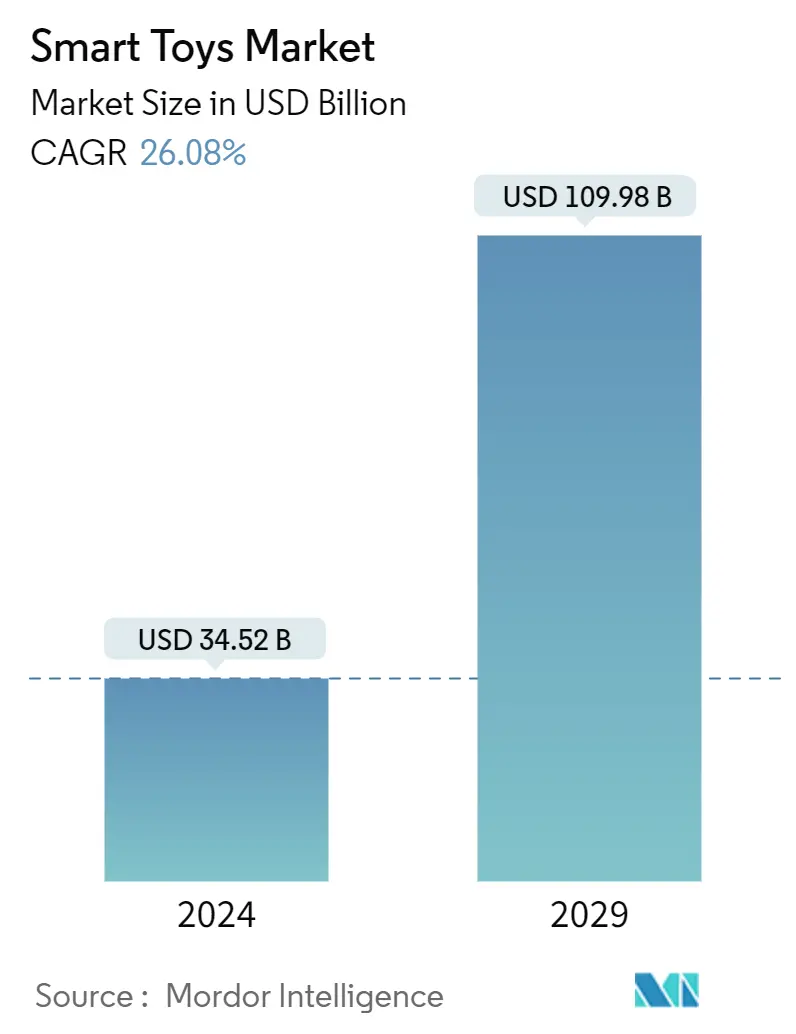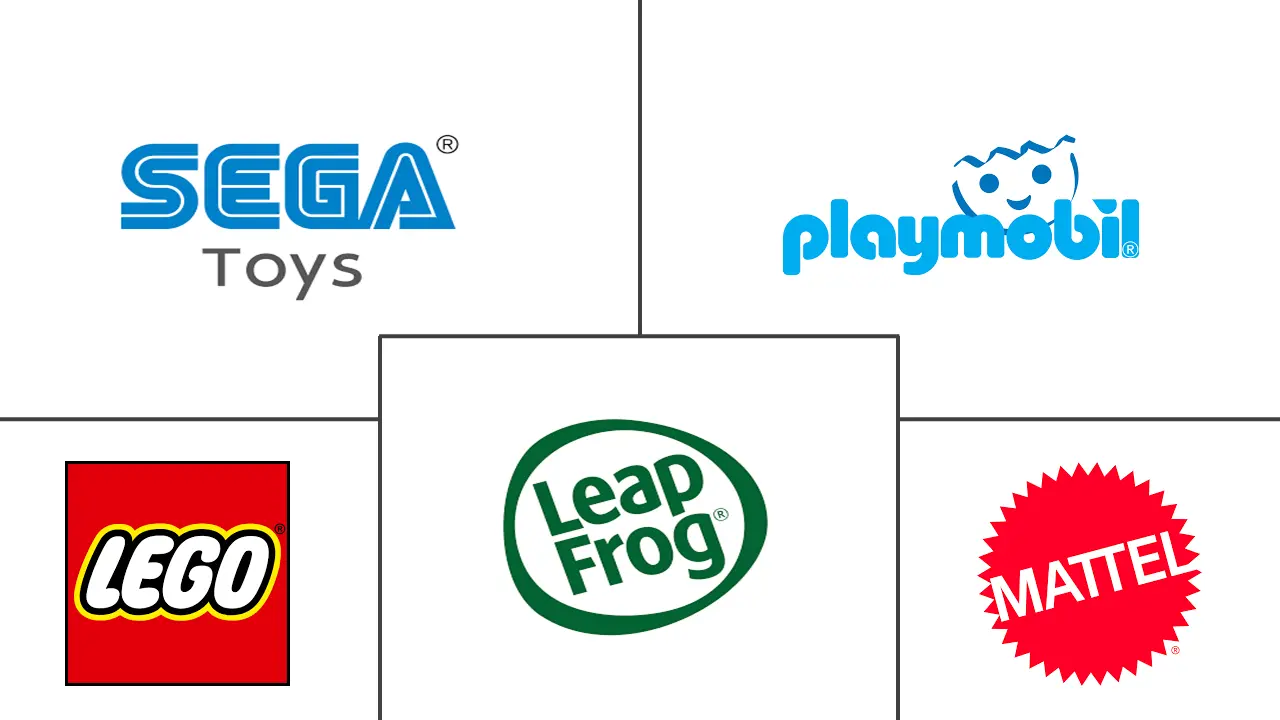Market Size of Smart Toys Industry

| Study Period | 2019 - 2029 |
| Market Size (2024) | USD 34.52 Billion |
| Market Size (2029) | USD 109.98 Billion |
| CAGR (2024 - 2029) | 26.08 % |
| Fastest Growing Market | Asia Pacific |
| Largest Market | Europe |
Major Players
*Disclaimer: Major Players sorted in no particular order |
Smart Toys Market Analysis
The Smart Toys Market size is estimated at USD 34.52 billion in 2024, and is expected to reach USD 109.98 billion by 2029, growing at a CAGR of 26.08% during the forecast period (2024-2029).
The fast acceptance of the Internet of Things (IoT) accelerated the development of smart and connected devices for a wide range of applications. A number of technologies are used in smart toys, including IoT, artificial intelligence, smart devices, and many more, to improve children's learning and enjoyment experiences.
- With inbuilt software that allows speech and picture recognition, app integration, radio-frequency identification (RFID) capability, and online searching features, these toys give a personalized play experience for youngsters. CogniToys' Dino, for example, uses Wi-Fi to stay connected and IBM Watson's natural language processing technology to adapt its replies based on the child's age and ability level
- The usage of STEM (Science, Technology, Engineering, and Math) toys to assist children in developing their skills is one of the primary factors fueling demand for smart toys. Smart toys increase professional talents such as computers and engineering through smart engagement and behavioral learning. As parents continue to embrace goods that can aid in their children's intellectual development, the use of smart toys will increase. SmartGurlz toy, for example, teaches females how to code.
- Various factors driving the growth of smart toys include direct and two-way communication, real-time tracking of children's activities, and the ability to store personal data such as a child's name, photos, and voice recordings, which aid in the personalization of toys. Fisher-Price, for example, sells a Smart Toy Bear that may be operated via a smartphone app. Over the projected period, such advancements are likely to boost the market.
- However, rising worries about data and privacy issues as smart toys become more prevalent are projected to stymie industry development. As a result, various regulatory agencies are taking major measures and actions to limit the hazards associated with the use of these smart toys.
- The COVID-19 epidemic has led to widespread lockdowns throughout the world. As a precautionary measure, the mandated lockdown has increased work-from-home practices and forced the closure of schools and other educational institutions. Many schools, colleges, and institutions have been shuttered across the world. Such developments have boosted the prospects for the worldwide adoption of smart toys since they support remote learning practices and give youngsters fascinating and immersive experiences.
Smart Toys Industry Segmentation
A smart toy incorporates technological advancements and intelligence by onboard electronics. These technologies enable the toys to learn and behave according to the pattern and alter their actions depending upon environmental stimuli. Typically, it can adjust to the abilities of the player.
The smart toys market is segmented by interfacing device (smartphones connected, tablet connected, and other interfacing devices (console connected)), technology (Wi-Fi, bluetooth, and other technologies), distribution channel (online stores, specialty stores, and convenience stores), and geography (North America, Europe, Aisa Pacific, and Rest of the World).
The market size and forecast are provided in terms of value (USD) for all the above segments.
| By Interfacing Devices | |
| Smartphone Connected | |
| Tablet-Connected | |
| Other Interfacing Devices (Console-connected) |
| By Technology | |
| Wi-Fi | |
| Bluetooth | |
| Other Technologies (NFC and RFID) |
| By Distribution Channel | |
| Online Stores | |
| Specialty Stores and Convenience Stores |
| By Geography | |
| North America | |
| Europe | |
| Asia Pacific | |
| Rest of the World |
Smart Toys Market Size Summary
The smart toys market is experiencing significant growth, driven by the rapid adoption of IoT and advanced technologies like artificial intelligence. These toys, equipped with features such as speech and picture recognition, app integration, and RFID capabilities, offer personalized and interactive play experiences that enhance children's learning and engagement. The increasing demand for STEM-based toys, which help develop skills in science, technology, engineering, and math, is a key factor propelling the market forward. As parents seek products that support their children's intellectual development, smart toys are becoming more popular. The COVID-19 pandemic has further accelerated this trend, as remote learning practices have highlighted the value of smart toys in providing immersive educational experiences.
The market is characterized by a high level of competition and fragmentation, with numerous players leveraging e-commerce and advanced technologies to expand their reach and product offerings. Companies like Mattel, Leapfrog, and Sega Toys are at the forefront, introducing innovative products that combine technology with traditional play. The European region, known for its early adoption of technology, is witnessing a surge in smart toy popularity, driven by the increasing use of building toys and the growing interest in interactive and educational play. Despite concerns over data privacy, the market is expected to continue its upward trajectory, supported by regulatory measures and industry initiatives aimed at ensuring safe and engaging experiences for children.
Smart Toys Market Size - Table of Contents
-
1. MARKET INSIGHTS
-
1.1 Market Overview
-
1.2 Industry Attractiveness - Porter's Five Forces Analysis
-
1.2.1 Bargaining Power of Suppliers
-
1.2.2 Bargaining Power of Buyers
-
1.2.3 Threat of New Entrants
-
1.2.4 Threat of Substitute Products
-
1.2.5 Intensity of Competitive Rivalry
-
-
1.3 Assessment of Impact of COVID-19 on the Market
-
-
2. MARKET SEGMENTATION
-
2.1 By Interfacing Devices
-
2.1.1 Smartphone Connected
-
2.1.2 Tablet-Connected
-
2.1.3 Other Interfacing Devices (Console-connected)
-
-
2.2 By Technology
-
2.2.1 Wi-Fi
-
2.2.2 Bluetooth
-
2.2.3 Other Technologies (NFC and RFID)
-
-
2.3 By Distribution Channel
-
2.3.1 Online Stores
-
2.3.2 Specialty Stores and Convenience Stores
-
-
2.4 By Geography
-
2.4.1 North America
-
2.4.2 Europe
-
2.4.3 Asia Pacific
-
2.4.4 Rest of the World
-
-
Smart Toys Market Size FAQs
How big is the Smart Toys Market?
The Smart Toys Market size is expected to reach USD 34.52 billion in 2024 and grow at a CAGR of 26.08% to reach USD 109.98 billion by 2029.
What is the current Smart Toys Market size?
In 2024, the Smart Toys Market size is expected to reach USD 34.52 billion.

